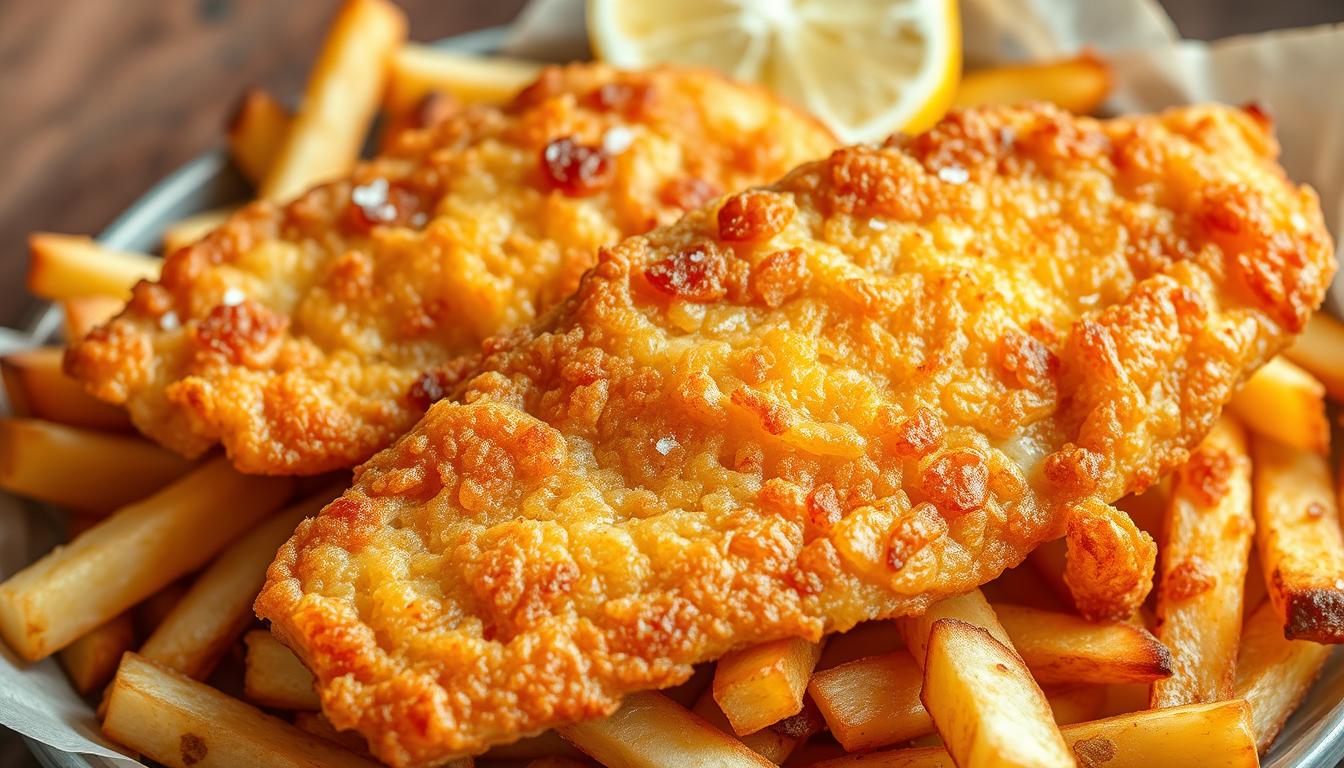How to Make the Best Crispy Fish and Chips Recipe at Home
Crispy Fish and Chips Recipe
Fish and chips is a beloved culinary tradition. It brings restaurant-quality comfort food to your kitchen. This easy fish and chips recipe turns simple ingredients into a crispy, golden-brown masterpiece. It will delight your taste buds and impress your family.
Learning to make the perfect crispy fish and chips at home is easier than you might think. With a few key techniques and the right ingredients, you can craft a delicious meal. This homemade fish and chips recipe will become a go-to favorite, whether you’re a cooking novice or an experienced home chef.
Get ready to discover the secrets of creating perfectly crisp fish. You’ll learn how to make a light, crunchy batter and golden, fluffy chips. Your culinary adventure starts right here!
Choosing the Right Fish
Creating the best fish and chips starts with picking the perfect fish. Not all seafood is the same for a crispy battered fish dish. This dish will impress your family and friends.
The key to great fish and chips is choosing the right fish. White fish varieties are best for this classic dish. They offer a delicate flavor and perfect texture for frying.
Best Fish for Frying
For crispy battered fish, focus on these top fish options:
- Haddock – A traditional favorite with a mild, sweet flavor
- Cod – The most classic choice for fish and chips
- Pollock – A sustainable alternative with similar texture
- Hake – A delicate white fish that fries beautifully
Sustainable Seafood Choices
Choosing sustainable seafood is key for flavor and the environment. Consider these options:
| Fish Type | Sustainability Rating | Flavor Profile |
|---|---|---|
| Pollock | Excellent | Mild, flaky |
| Hake | Good | Delicate, sweet |
| Pacific Cod | Good | Classic fish and chips flavor |
Pro tip: Buy from reputable fishmongers who can verify the fish’s origin and sustainability. Fresh fish makes all the difference in creating restaurant-quality fish and chips at home.
Remember, the quality of your fish determines the ultimate success of your crispy battered fish recipe!
Preparing the Batter
Making the perfect batter is key for tasty fish and chips. The right mix of ingredients makes your homemade dish stand out. Your batter’s crispiness and flavor are what make the dish great.

Essential Ingredients for a Crispy Batter
For crispy fish and chips, pick your ingredients wisely. The right mix is crucial for a great batter:
- All-purpose flour – The main ingredient for your batter
- Rice flour – Adds extra crispiness
- Baking powder – Makes the batter light and airy
- Cold beer – Adds carbonation and flavor
- Vodka – Helps make the coating super crispy
Step-by-Step Batter Preparation Technique
Here’s how to make the perfect batter for your fish and chips:
- Start with 1 cup all-purpose flour and 1/4 cup rice flour
- Add 1 teaspoon baking powder
- Whisk in cold beer and a bit of vodka
- Mix until it’s smooth but not too thick
- Let it rest for 15 minutes before frying
Pro tip: Cold ingredients and gentle mixing are essential for a light, crispy batter.
The secret to amazing fish and chips is in the batter. By choosing the right ingredients and following these steps, you’ll get a batter that’s golden, crispy, and irresistible.
Cooking the Chips
Making the perfect chips is key to a great fish and chips recipe. The British are known for their chips, turning simple potatoes into a dish that’s a must-try. It’s what makes traditional fish and chips so special.
Choosing the right potatoes is the first step to getting that authentic UK style crunch. Not all potatoes are good for frying.
Potato Varieties for Perfect Chips
- Maris Piper: The gold standard for British chips
- King Edward potatoes
- Russet potatoes
Chip Preparation Techniques
The secret to crispy chips is in how you prepare them. Cut your potatoes into thick, even strips about 1/2 inch wide. Keep some skin on for extra texture and a rustic look.
- Wash potatoes thoroughly
- Cut into uniform strips
- Soak in cold water to remove excess starch
- Pat completely dry before frying
The double-frying method is crucial for that perfect golden outside and fluffy inside. First, fry at a lower temperature (around 325°F) to cook the inside. Then, raise the heat to 375°F for a crispy finish.
Pro tip: Always use fresh oil and maintain consistent temperature for the best results!
Sprinkle your chips with sea salt right after frying to keep in the flavor. Your homemade chips will be just as good as any from a British chip shop!
Frying Techniques for Perfect Fish
Mastering the art of frying is key to making the best fish and chips. The right technique can turn your dish from good to great. Cooking fish needs precision and skill to get that golden, tasty outside while keeping the inside tender and flavorful.

When making your delicious fish and chips, you have two main frying methods:
Comparing Frying Methods
- Deep Frying: Creates a uniform golden-brown coating
- Completely submerges fish in hot oil
- Provides even cooking
- Produces maximum crispiness
- Pan Frying: Offers more control but requires careful attention
- Uses less oil
- Works well for smaller portions
- Requires more manual flipping
Temperature Control Secrets
Professional chefs say temperature is the key to perfect fish. Your oil should be heated to exactly 350°F (175°C). Use a cooking thermometer to ensure precise temperature control.
“The secret to crispy fish is hot oil and quick cooking!” – Professional Chef’s Tip
Here are some critical temperature management tips:
- Preheat oil to the correct temperature
- Avoid overcrowding the cooking vessel
- Let oil recover temperature between batches
- Use a thermometer for consistent results
By following these techniques, you’ll make fish that’s crispy on the outside and perfectly cooked inside. Practice makes perfect with your crispy fish and chips recipe!
Serving Your Fish and Chips
When it comes to traditional fish and chips UK style, how you present it matters a lot. The right touches can make a simple meal into a memorable experience. Your classic fish and chips need the perfect finishing touches to go from good to great.
Serving fish and chips is more than just putting it on a plate. It’s about creating a full sensory experience. This experience should capture the true essence of traditional fish and chips.
Classic British Accompaniments
Every authentic fish and chips meal comes with special side items. These items complement the crispy seafood and potatoes perfectly:
- Malt Vinegar: The quintessential condiment that brings tangy brightness
- Mushy Peas: A traditional British side that adds color and texture
- Pickled Onions: Sharp and zesty flavor enhancers
- Lemon Wedges: For a fresh citrus touch
Irresistible Dipping Sauces
Elevate your fish and chips UK style with these tasty dipping options:
- Classic Tartar Sauce: Creamy and herbaceous
- Spicy Sriracha Mayo: For those who love a kick
- Curry Sauce: A unique British-Indian fusion
- Garlic Aioli: Rich and sophisticated
Pro tip: Use a spray bottle for malt vinegar to evenly distribute flavor without making your classic fish and chips soggy. Serve immediately for maximum crispiness and enjoyment.
Tips for Restaurant-Quality Results
To make the best fish and chips at home, you need more than a simple recipe. Professional chefs use small techniques to make meals special. With a few tricks, your homemade fish and chips can be as good as those in restaurants.
Dry brining is a key to better fish and chips. Salting the fish and letting it rest for 4-8 hours improves texture and taste. This method helps the fish fry up crispy and flavorful.
Common Mistakes to Avoid
Many people struggle with soggy batter and overcooked fish. To avoid this, keep your oil at 350-375°F and don’t overcrowd the pan. A kitchen thermometer is crucial for the right temperature and a crispy exterior.
Pro Chef Secrets
Professional chefs mix different flours and add vodka to their batter. The vodka prevents gluten formation, making the batter extra crispy. This trick gives your fish and chips a light, airy texture that’s perfect for a restaurant-quality meal.
Table of Contents
FAQ
What is the best type of fish for making fish and chips?
Cod and haddock are top picks for their mild taste and flaky texture. Pollock, halibut, and Pacific halibut are also great. Choose fresh, firm white fish that holds up well to frying.
How do I keep my batter crispy and prevent it from becoming soggy?
Keep your oil hot (350-375°F) and drain fish on a wire rack. Serve right away. Beer in the batter and cornstarch or vodka can make it extra crispy.
What type of potatoes work best for making authentic chips?
Russet or Maris Piper potatoes are best for crispy chips. They’re high in starch for a fluffy inside and crispy outside. Cut thick and double-fry for the perfect crunch.
How can I tell if the oil is at the right temperature for frying?
Use a digital thermometer for 350-375°F. Or, test with a small bread piece – it should sizzle and brown in 60 seconds.
What are some traditional accompaniments for fish and chips?
Try malt vinegar, mushy peas, tartar sauce, and pickled onions. Salt and lemon wedges add extra flavor.
Can I make fish and chips ahead of time?
Best served fresh for crispiness. If ahead, warm in a 200°F oven briefly. But it won’t be as crispy.
What’s the secret to preventing greasy fish and chips?
Keep oil hot, use light batter, and drain on a wire rack. Don’t overcrowd the fryer to avoid greasiness.
Are there any gluten-free options for making fish and chips?
Yes, use gluten-free flours like rice or cornstarch. Make sure all ingredients, including beer, are gluten-free.
Tried & Tested: Is Worth It?
There are no reviews yet. Be the first one to write one.

